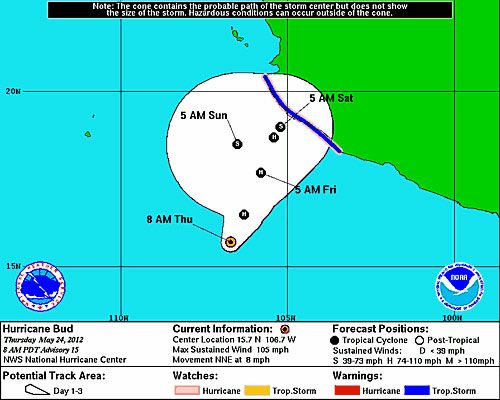
Bud Becomes A Hurricane in East Pacific

Tropical Storm Bud became a hurricane overnight, the first of the season in the Eastern Pacific Ocean, and has continued to strengthen as it whirls off the west coast of Mexico.
Bud became a hurricane at 11:00 p.m. PDT yesterday (May 23), putting coastal Mexican communities on alert.
The storm currently has maximum sustained winds of 105 mph (165 kph) — making it a Category 2 hurricane — and is about 280 miles (445 kilometers) southwest of Manzanillo, Mexico.
A tropical storm warning and hurricane watch have been issued by the National Hurricane Center in Miami for the coast of Mexico from Punta San Telmo westward to Cabo Corrientes. The tropical storm warning means that tropical storm conditions are expected within the area in the next 24 to 36 hours, and the watch that hurricane conditions are possible there within 48 hours.
Hurricane Bud is moving to the north-northeast at about 8 mph (13 kph) and the center of the storm is expected to be near or just offshore of the southwestern coast of Mexico between late Friday and Saturday.
The storm could strengthen more today before forecasters expect it to start weakening tonight.
Hurricane hunters with the U.S. Air Force Reserve are slated to fly into the storm this afternoon to investigate its winds and structure.
Sign up for the Live Science daily newsletter now
Get the world’s most fascinating discoveries delivered straight to your inbox.
Satellites are also keeping an eye on bud, measuring the amount of rain it generates and watching its forward movement. Earlier this week, satellites also noted so-called "hot tower" rain clouds in then-Tropical Depression 2E, that signaled it would strengthen into Tropical Storm Bud.

Andrea Thompson is an associate editor at Scientific American, where she covers sustainability, energy and the environment. Prior to that, she was a senior writer covering climate science at Climate Central and a reporter and editor at Live Science, where she primarily covered Earth science and the environment. She holds a graduate degree in science health and environmental reporting from New York University, as well as a bachelor of science and and masters of science in atmospheric chemistry from the Georgia Institute of Technology.











